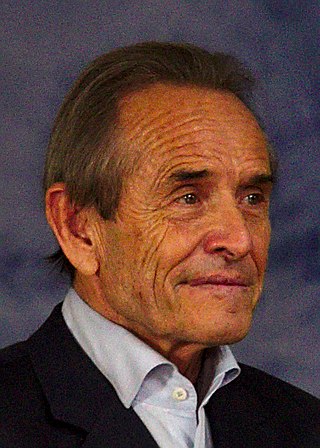
Jacques Bernard Edmon Martin Henry "Jacky" Ickx is a Belgian former racing driver who won the 24 Hours of Le Mans six times and achieved eight wins and 25 podium finishes in Formula One. He greatly contributed to several World Championships for Makes and World Sports Car championships: Ford (1968), Ferrari (1972), Porsche (1976–1977) and (1982–1985) by his 37 major World Sports Car wins. He also won the Can-Am Championship in 1979 and the 1983 Paris–Dakar Rally.

Sir John Young Stewart OBE is a British former Formula One racing driver from Scotland. Nicknamed the "Flying Scot", he competed in Formula One between 1965 and 1973, winning three World Drivers' Championships and twice finishing as runner-up over those nine seasons. He was the only British driver to win three championships until Lewis Hamilton in 2015.
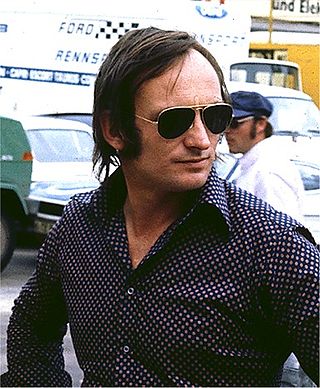
Christopher Arthur Amon was a New Zealand motor racing driver. He was active in Formula One racing in the 1960s and 1970s, and is widely regarded as one of the best F1 drivers never to win a championship Grand Prix. His reputation for bad luck was such that fellow driver Mario Andretti once joked that "if he became an undertaker, people would stop dying". Former Ferrari Technical Director Mauro Forghieri stated that Amon was "by far the best test driver I have ever worked with. He had all the qualities to be a World Champion but bad luck just wouldn't let him be".

Daniel Sexton Gurney was an American racing driver, race car constructor, and team owner who reached racing's highest levels starting in 1958. Gurney won races in the Formula One, Indy Car, NASCAR, Can-Am, and Trans-Am Series. Gurney is the first of three drivers to have won races in sports cars (1958), Formula One (1962), NASCAR (1963), and Indy cars (1967), the other two being Mario Andretti and Juan Pablo Montoya.

Karl Jockum Jonas "Joakim" Bonnier was a Swedish sportscar racing and Formula One driver who raced for various teams. He was the first Swede to both enter and win a Formula One Grand Prix.

Pedro Rodríguez de la Vega was a Mexican racing driver. He began his Formula One career in 1963, won the 1967 South African Grand Prix in a Cooper and the 1970 Belgian Grand Prix in a BRM. He was the older brother of Ricardo Rodríguez.

The Porsche 917 is a sports prototype race car developed by German manufacturer Porsche to exploit the regulations regarding the construction of 5-litre sports cars. Powered by a Type 912 flat-12 engine which was progressively enlarged from 4.5 to 5.0 litres, the 917 was introduced in 1969 and initially proved unwieldy on the race track but continuous development improved the handling and it went on to dominate sports-car racing in 1970 and 1971. In 1970 it gave Porsche its first overall win at the 24 Hours of Le Mans, a feat it would repeat in 1971. It would be chiefly responsible for Porsche winning the International Championship for Makes in 1970 and 1971. Porsche went on to develop the 917 for Can-Am racing, culminating in the twin-turbocharged 917/30 which was even more dominant in the role. Porsche drivers would win the Can-Am championship in 1972 and 1973. 917 drivers also won the Interserie championship every year from 1969 to 1975.

Joseph Siffert was a Swiss racing driver.

Keith Jack Oliver is a British former Formula One driver and team-owner from England. He became known as the founder of the Arrows team as well as a racing driver, although during his driving career he won both the 24 Hours of Le Mans race and the Can-Am championship. Oliver was also the second person to complete the informal triple Crown of endurance racing.
Michael Henderson Spence was a British racing driver from Surrey in England. He participated in 37 Formula One World Championship Grands Prix, debuting on 8 September 1963. He achieved one podium, and scored a total of 27 championship points. He also participated in numerous non-Championship Formula One races, as well as sports car racing.

Àlex Soler-Roig i Janer is a former racing driver from Barcelona, Spain. He participated in 10 Formula One World Championship Grands Prix, debuting on 19 April 1970, and scored no championship points. He also participated in several non-Championship Formula One races.
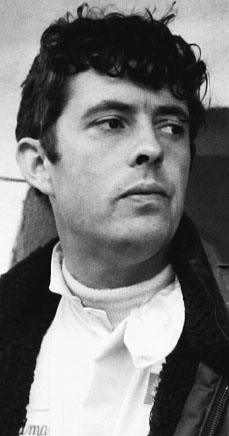
Brian Herman Thomas Redman, is a retired British racing driver.
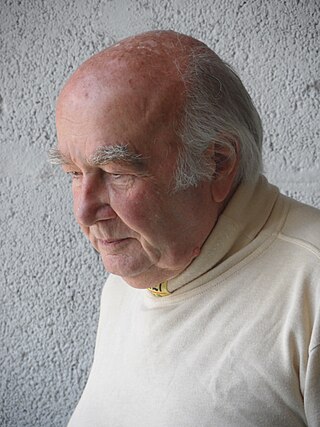
David Ruff Piper is a British former Formula One and sports car racing driver from England. He participated in 3 Formula One World Championship Grands Prix, debuting on 18 July 1959. He scored no championship points.

Derek Reginald Bell is a British racing driver. In sportscar racing, he won the Le Mans 24 hours five times, the Daytona 24 three times and the World Sportscar Championship twice. He also raced in Formula One for the Ferrari, Wheatcroft, McLaren, Surtees and Tecno teams. He has been described by fellow racer Hans-Joachim Stuck as one of the most liked drivers of his generation.

Vernon John Schuppan is a retired Australian motor racing driver. Schuppan drove in various categories, participating in Formula One, the Indianapolis 500 and most successfully in sports car racing.
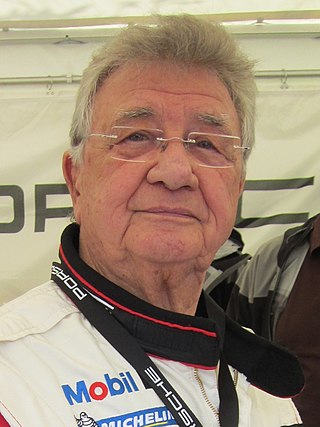
Hans Herrmann is a retired Formula One and sports car racing driver from Stuttgart, Germany.

Mark Neary Donohue Jr., nicknamed "Captain Nice," and later "Dark Monohue," was an American race car driver and engineer known for his ability to set up his own race car as well as driving it to victories.

Ferrari 512 S is the designation for 25 sports cars built in 1969–70, with five-litre 12-cylinder ("512") engines, related to the Ferrari P sports prototypes. The V12-powered cars were entered in the 1970 International Championship for Makes by the factory Scuderia Ferrari and private teams. Later that year, modified versions resembling their main competitor, the Porsche 917, were called Ferrari 512 M. In the 1971 International Championship for Makes, the factory focused on the new Ferrari 312 PB and abandoned the 512 which was only entered by privateers. From 1972 onwards, the 512 was withdrawn from the world championship following a change in the regulations, and some 512s in private hands were entered in CanAm and Interserie races.
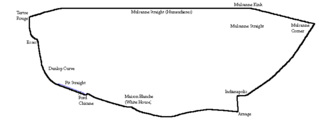
The 1969 24 Hours of Le Mans was a motor race staged at the Circuit de la Sarthe, Le Mans, France on 14 and 15 June 1969. It was the 37th Grand Prix of Endurance and was the eighth round of the 1969 International Championship for Makes. The race was open to Group 6 Prototype Sports Cars, Group 4 Sports Cars and Group 3 Grand Touring Cars.
Tetsu Ikuzawa is a Japanese former racing driver, team executive, and businessman from Tokyo, Japan. He is one of the most successful and prolific Japanese drivers from the early years of the nation's automobile racing history. Ikuzawa was the first Japanese driver to regularly compete in a number of notable European championships, namely the British Formula Three Championship and European Formula Two Championship. He was also one of the first Japanese drivers to compete in the 24 Hours of Le Mans endurance race, making his first start in 1973 for Sigma Automotive alongside his countryman, Hiroshi Fushida. In domestic competition, Ikuzawa won the 1964 and 1967 Japanese Grand Prix sports car races, and the 1977 Fuji Grand Champion Series.





















